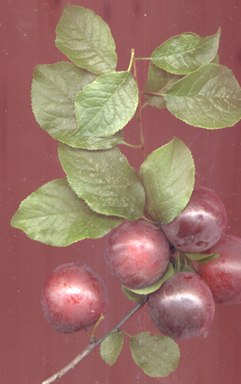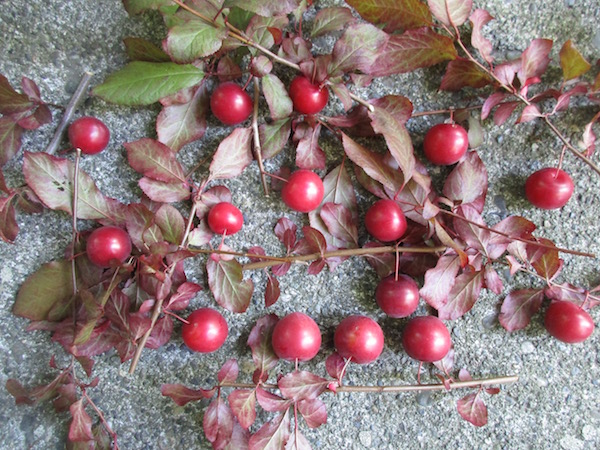Plant of the Month: August 2004
|
| Mexican Plum |
Prunus mexicana S. Wats.
|
(Prunus americana var. lanata MISAPPLIED)
|
(ROSACEÆ); Rose Family
|
| Plum trees intrigue me, whether they are wild or cultivated, and whether people cherish them for beauty or fruit. Over the years I have enjoyed learning much about them. My 1992 book Purpleleaf Plums accounted for 50 different kinds of plum trees or shrubs whose foliage is more or less reddish-purple. |
| Most of the plum trees in Seattle are ornamentals; they are sold and planted primarily for people to look at rather than to yield us fruit. The fruiting plum trees present here are routinely divided into two groups, European and Japanese. On the whole, North American native plum species and hybrids perform poorly here, because most of them thrive in a continental climate, not a modified Mediterranean one such as Seattle has. |
| In the whole city I am aware of only one Mexican plum, and therefore shall share its story. My friend Esiquio Narro (1914 - 1999) traveled several times from Seattle to Mexico in the 1980s. Esiquio was an avid and learned fruit grower, propagator and teacher. He was impressed with some of the plums he encountered in Mexico. At one time he brought back to Seattle some seeds. He raised more than one such tree, and on March 8th 1991 my brother and I transplanted one from Esiquio's garden north of Seattle, to the property in Seattle where my brother lived, on N 53rd Street, just east of Green Lake Way N. |
The transplanted tree grew vigorously. It is currently taller than the house chimney, and its trunk is 11 inches thick. It serves as a flowering tree in spring, as a small shade tree in summer, and it yields large loads of plums. To begin with it had been a spiny, congested and graceless tree, but over the years has aged into a handsome and appreciated specimen.
|
| As I observed it early on, I could not comfortably distinguish it from the Old World cherry plum, Prunus cerasifera. But now I can look at the Mexican tree, and see that its less vertical, more wavy branching habit, its higher gloss leaves, and its more meaty, less watery, plums --all separate it. |
| I do not know is if this tree from Mexico is a representative example of Prunus mexicana, a species native in Northeast Mexico and the central United States. For the time being I am assuming that it is, or that it is a cultivated variety thereof, or maybe even a hybrid with the cherry plum. My research on plums revealed that the cherry plum hybridizes readily with various other plums and plum-like relatives. |
| In reading descriptions of Prunus mexicana as it is found in Texas, Louisiana, and so on, I see that the species is noted for being a single-trunked tree that rarely or does not develop suckering thickets as do most U.S. native plums --such as its close cousin Prunus americana. Mexican plum also is prized for its lovely fragrant white spring flowers. But its fruit is not much esteemed; and its seedlings can be weedy. Well, in Seattle cherry plum seedlings come up wild left and right; but so far I have noticed no Mexican seedlings. |
Prunus mexicana is also called big tree plum and inch plum. It was named in May 1882 by Sereno Watson, in a disappointingly vague description, based on a herbarium specimen collected by Dr. E. Palmer in 1880 in Coahuila, Mexico. Though some selections were made of its better fruiting examples decades ago or even in the 1800s, the species has played almost no role in ornamental horticulture outside of Texas. In the 1980s a cultivar was selected and named Bright Star by Lone Star Growers nursery of San Antonio. But Color Spot Nurseries bought Lone Star, and I do not think Bright Star still exists in commerce, nor do I know its distinguishing attributes.
|
The Seattle house with the enigmatic, unique plum tree, is now for sale. I will gather some plums there and save the seeds to sow. I am curious as to what kind of offspring may result. Not far away up the block are three Trailblazer Plum street-trees. Trailblazer is a complex hybrid with purple leaves and large good fruit, and if its pollen was to result in fertilizing a Mexican flower, then any seedling resulting therefrom would boast ancestry including Prunus mexicana, P. cerasifera, P. salicina, P. Simonii, and P. angustifolia. If I get no germination at all maybe that suggests that the Mexican tree is a sterile hybrid. (I sowed 47 seeds in my garden in January 2005. Only 5 sprouted! Four out of five were purple-leaved. At first, the greenleaf specimen was the runt of the litter, but as of 2011, it was the tallest. It also bloomed first, in 2014; they are crowded. By 2017, the Seattle parent tree has been cut down, and my first crop of fruit appeared on one of my seedlings; its leaves are greenish above and purplish beneath; its plums are dark red and small: from just over three-forths of an inch to one and one-eighth of an inch wide. Note the photo I added below)
Back |

Prunus mexicana scan by ALJ
|

Prunus mexicana seedling leaves and plums in August 2017 ; photo by ALJ
|
|
|

